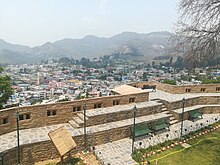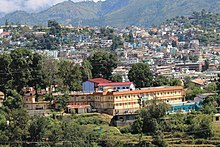Pithoragarh
Tradition has it that during the reign of the Chand Rajas of Kumaon, one Piru, also called Prithvi Gosain, built a fort here and named it Prithvigarh which, in the course of time, got changed to Pithoragarh.
"[2] Pithoragarh city and its surrounding areas were part of the Manaskhand region, which extended from the Kailash Mountain in the north to Bhabar & Terai in the south, as mentioned in the Skanda Purana.
[3]: 16 The region subsequently came under the Kurmanchal kingdom, which had its capital first at Jyotirmath and then at Karikeyapura (Modern day Baijnath) in the Katyur Valley.
[4] The Group of Temples at Kasni village (3 km from city centre) were built in 11th century during the rule of Katyuri kings.
[5] Upon the disintegration of the Katyuris and fall of kingdom in 13th century, Pithoragarh came under the rule of Bam kings of Saur.
The Quit India Movement of 1942 found greater support in Pithoragarh and about 150 persons were arrested while several were fined.
The winter season brings pleasant afternoons, very cold mornings, and spells of frontal rain accompanied by sparse snowfall.
Pithoragarh is an urban town with a Nagar Palika Parishad or Municipal Council[12] spread over an area of 9 square km.
There was no elected body and the affairs were supervised by an Officer-in-charge (a deputy collector) to whom the powers were delegated by the District Magistrate.
[3]: 157 Pithoragarh Mahotsav has played a significant role in conserving and sharing Pithorgarh's unique culture.
Local people, known as Shaukars or Rangs, take part in the week-long festival with joy and enthusiasm in various villages throughout the region.
Then, the women and men, in traditional dresses and laden with gold and silver ornaments, assemble around a tree on the sacred ground of the village.
The festival, which originated in West Nepal's Sorar (Mahakali) region, was first introduced to the valley in Kumor village, Pithoragarh.The hiljatra of Urai (Dewalthal)is the most famous.Tha tableau of the Lakhiya bhoot is the main attraction.On the evening of hiljatra,worship of goddess Mahakali is performed tableaux are tajen out.The people of Bajethi, another village near Pithoragarh, accepted the Jatra, and it was modified and introduced as Hiran chital in the Kanalichhina and Askot regions.
Hilljatra is linked to ropai (paddy planting) and other rainy-season agricultural and pastoral labours (Hill = mud, Jatra = Jaat).
Major parts of the Bollywood film Sandeep Aur Pinky Faraar have been shot in the city.
[20] Landslides and cloudbursts, caused by heavy rains that fall during the summer monsoon, often interrupt transportation networks.
Schools in Pithoragarh are run by the state government or private organisations, Hindi and English are the primary languages of instruction.
Construction of a medical college is proposed by the state government and it has been allotted a budget of ₹450 crores ($64 million).







